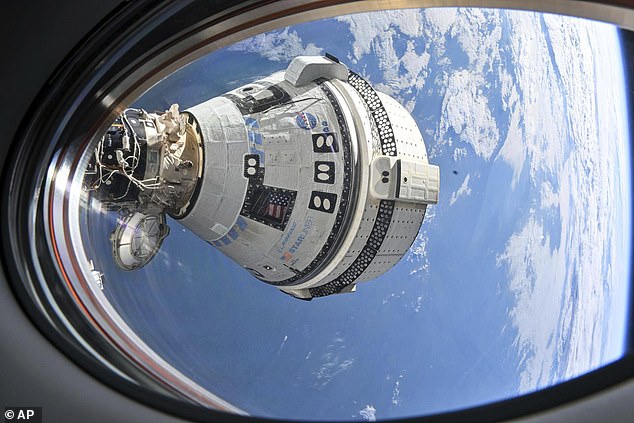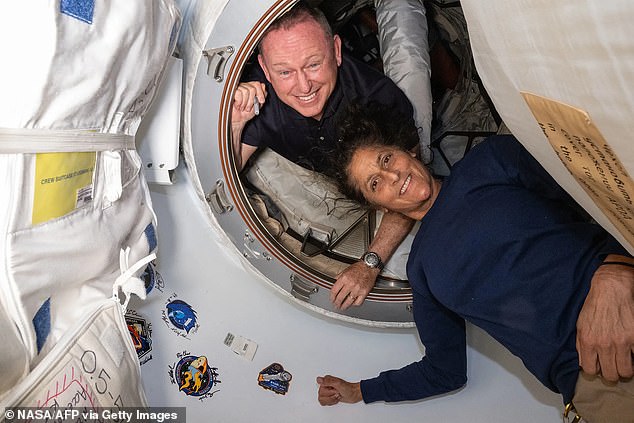Boeing’s stranded astronaut fiasco takes sickening twist that could leave NASA duo stuck in space for even longer
A fiery explosion of a Space X rocket this week could spell more misery for NASA’s two astronauts stranded in space.
The unmanned Falcon 9 rocket failed to land successfully after launching satellites into space. The rocket caught fire and then fell on its side.
This is bad news for the two astronauts who were stranded for nearly three months aboard the International Space Station (ISS) on Boeing’s malfunctioning Starliner.
Their only hope is to return to Earth in SpaceX’s Dragon capsule, which will be launched on Falcon 9 rockets and should bring them home in February 2025.
But the latest setback threatens to push that date back even further.
A complete timeline of Boeing’s Starliner program, from the singing of their giant contact to the incident that left two astronauts stranded aboard the ISS.
The FAA must now launch an investigation into what went wrong with the Falcon 9, which could throw off SpaceX’s rescue mission planning and ultimately significantly delay Crew Dragon’s launch date.
“Depending on the circumstances, some accident investigations can be completed in a matter of weeks. Other, more complex investigations can take several months,” the agency’s website states.
Additionally, SpaceX plans to use the Falcon 9 to launch the Crew Dragon spacecraft, meaning the Starliner crew’s return to Earth will depend on the booster working.
However, recent technical problems with the booster suggest that a successful September launch is not entirely guaranteed.
The worst-case scenario — a lengthy FAA investigation followed by more problems with the Falcon 9 — could further delay Crew Dragon’s launch.
SpaceX did not immediately respond to DailyMail.com’s request for comment.
On June 5, NASA astronauts Sunita Williams and Barry Wilmore launched to the ISS aboard Boeing’s Starliner.
The scandal-plagued Starliner, built and developed with more than $4 billion in taxpayer money, was plagued by helium leaks and booster problems in the weeks leading up to launch and even on the day itself.
The spacecraft safely delivered Williams and Wilmore to the ISS, but by the time it arrived, helium particles were leaking again and five of its 28 thrusters had failed.

Boeing’s Starliner spacecraft had been experiencing technical problems even before its June 5 launch, and NASA ultimately decided it was no longer safe to send the crew back to Earth.
Williams and Wilmore were originally only supposed to stay on the ISS for eight days, but technical problems with their spacecraft have now kept them stuck for almost three months.
At a press conference on August 24, NASA officials said it would be too risky to take the astronauts home in the disabled Starliner.
Instead, they will return home on SpaceX’s Crew Dragon spacecraft, which will launch NASA astronaut Nick Hague and Russian cosmonaut Alexander Gorbunov to the ISS on Sept. 24, according to a statement from NASA today.
This means that Williams and Wilmore will remain on the ISS until February 2025 at the latest.
The decision was humiliating for Boeing, which has struggled for years to get its Starliner program off the ground, only to be rescued at the last minute by its biggest competitor.
“We’ve had so many embarrassing situations lately, we’re under a microscope. This just made it 100 times worse,” an anonymous employee told the New York Post.
“We hate SpaceX,” he added. “We talk about them all the time, and now they’re saving us.”
It is currently unclear whether Starliner will ever be able to complete a manned mission to the ISS.
NASA plans to retire the ISS by 2030, leaving Boeing with just five years to fix Starliner’s technical issues and successfully send astronauts to and from space.
To put that in perspective, it’s been five years since Starliner’s first unmanned test flight failed.
However, it is possible that Boeing will phase out the Starliner before the deadline is reached, as the company has already poured $1.6 billion into developing the spacecraft.

SpaceX’s Falcon 9 caught fire in a landing accident that occurred after a launch that carried 21 Starlink satellites into low Earth orbit. The FAA plans to investigate the incident
The Falcon 9 booster failed after a successful launch from Cape Canaveral, Florida, early Wednesday morning as part of a mission to launch 21 Starlink satellites into low-Earth orbit. This was the rocket’s 23rd launch.
The launch went smoothly, and the booster was able to separate from the upper stage before beginning its return to Earth. But things went downhill from there.
The first stage of the Falcon 9 rocket failed to land on its intended target: an unmanned drone ship called ‘A Shortfall of Gravitas.’
Instead, the booster exploded in flames and then fell on its side.
While the mission was a success overall, the Federal Aviation Administration has halted further launches of the Falcon 9 until the cause of the accident is determined.
“The resumption of flight of the Falcon 9 rocket is based on the FAA’s determination that any system, process or procedure related to the anomaly does not pose a risk to public safety,” FAA officials said in a written statement.

The launch of the SpaceX Polaris Dawn mission (pictured) has been postponed indefinitely pending an FAA investigation into a failed Falcon 9 landing

The crew for the Polaris Dawn mission includes (left to right) billionaire Jared Isaacman, SpaceX engineers Anna Menon and Sarah Gillis, and Air Force Lt. Col. Scott Poteet
This is the second time in the past two months that the FAA has grounded the Falcon 9.
The agency halted Falcon 9 launches for two weeks in July after one of the liquid oxygen tanks in the rocket’s upper stage leaked, causing several satellites to fail to deploy properly and burn up in Earth’s atmosphere.
It’s unclear how long this new investigation will last. In the meantime, a crew of four SpaceX astronauts awaits the launch of the Polaris Dawn mission, which will take them to orbit on Falcon 9 for five days.
The mission, funded and crewed by entrepreneur Jared Isaacman, is expected to make history by reaching higher altitudes than humans have gone since NASA’s Apollo program in the 1970s and will also conduct the first commercial spacewalk.

Life aboard the ISS is very cramped and astronauts Barry Wilmore (left) and Sunita Williams (right) will be on board for another six months.
But Polaris Dawn has been delayed several times due to adverse weather conditions and technical issues, after it was originally scheduled for launch on Tuesday.
Friday would have been the earliest possible date for Polaris Dawn to launch, but the FAA’s investigation has now left the mission in limbo.
As for the stranded Starliner crew, they will just have to hope that the FAA’s investigation continues and that Falcon 9 successfully launches the Crew Dragon mission in September.
Meanwhile, Boeing’s Starliner will return to Earth unmanned on September 6, NASA said.
NASA officials said the astronauts are doing “fine” and are busy with daily tasks and science experiments.
But it’s likely they’re feeling frustrated after a mission that should have lasted a week turned into an eight-month nightmare.
